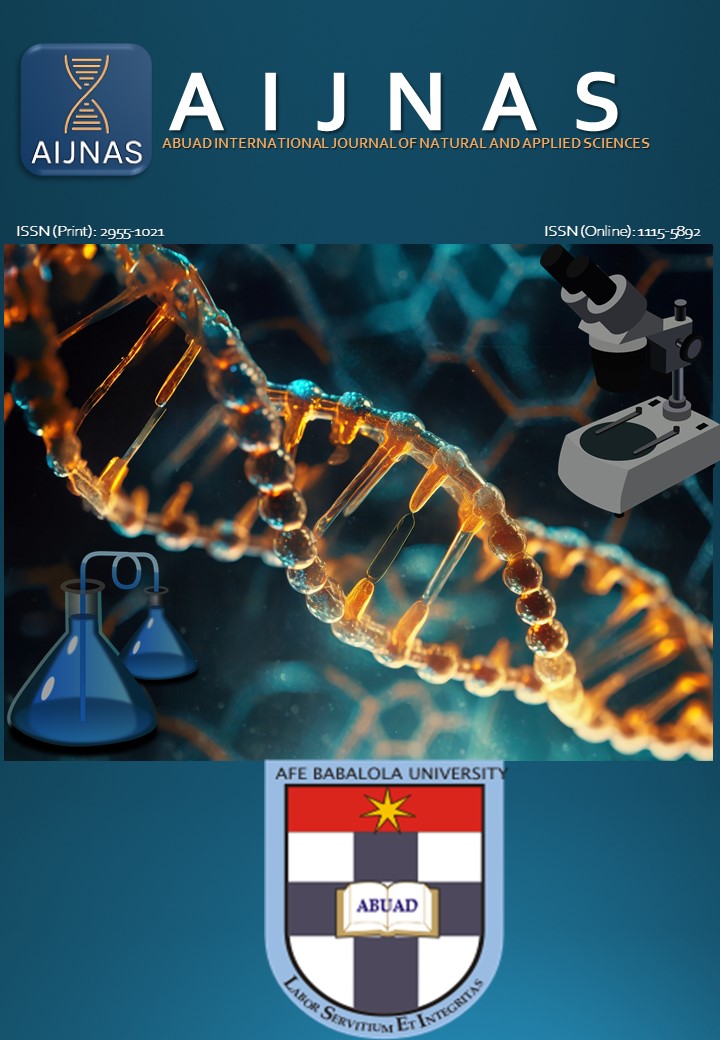Assessment of Water use Trends, Usage Frequency, and Heavy Metals Contamination in Elemi and Ogbese Rivers in Ado-Ekiti, Ekiti State
Main Article Content
Abstract
Heavy metal levels in Elemi and Ogbese Rivers surpass WHO standards, endangering community health. Limited awareness, linked to education gaps, increases exposure risks. Urgent action is needed to improve water safety and public health awareness. Hence, this study investigated water usage trends and heavy metal contamination in Elemi and Ogbese Rivers in Ado-Ekiti, Nigeria. Data on demographic characteristics were collected through a guided questionnaire administered to 150 adults each, aged 18-55, from the two communities. Metals (Hg, Cr, Pb, Zn, Co, Cd) analyses in the water samples were carried out using Atomic Absorption Spectroscopy AAS. Statistical analysis was performed with IBM SPSS 29 with significance at p<0.05. The study revealed significant differences in educational levels and employment status between the two communities, with Elemi having higher frequencies than Ogbese in both parameters. The frequency of water usage showed that Ogbese consumed a higher daily water intake (12%) than Elemi (6%), a marker for a potentially increased susceptibility to contaminant contact through frequent water use. Education and occupation significantly influenced water usage in both rivers, while gender significantly influenced water usage in the Ogbese River only. There was higher awareness of heavy metal pollution in Elemi (36.0%) compared to Ogbese (10.0%). However, awareness of heavy metal pollution and effluent discharge is significantly correlated to education. Mean metal
concentrations in Ogbese River and Elemi River were higher than the WHO recommended values, indicating a possible health hazard for communities that rely on these rivers. Low community awareness of heavy metal contamination poses significant public health risks, as
river concentrations exceed WHO standards. Educational disparities affect awareness and water usage behaviours, emphasising the need for targeted interventions. Regulatory measures are necessary to control effluent discharge into rivers, Ongoing environmental monitoring
is crucial for sustained protection. Community engagement remains key to safeguarding public health and ecosystems
Downloads
Article Details

This work is licensed under a Creative Commons Attribution-NonCommercial-NoDerivatives 4.0 International License.
Authors hold the copyright of all published articles except otherwise stated.
References
Adebayo I.A. Determination of Heavy Metals in Water, Fish and Sediment from Ureje Water Reservoir. J Environ Anal Toxicol. 2017;7:486. doi: 10.4172/2161-0525.1000486. Adesiyan, I. M., Bisi-Johnson, M., Aladesanmi, O. T., Okoh, A. I., & Ogunfowokan, A. O. (2018). Official Journal of College of Sciences, Afe Babalola University, Ado-Ekiti, Nigeria. 45 Oluwagbemi et al., 2025 AJINAS, 5 (1) Concentrations and Human Health Risk of Heavy Metals in Rivers in Southwest Nigeria. Journal of Health & Pollution, 8(19). https://doi. org/10.5696/2156-9614-8.19.180907 Afzaal, M., Hameed, S., Liaqat, I., Ali khan, A. A., abdul Manan, H., Shahid, R., & Altaf, M. (2022). Heavy Metals Contamination in water, Sediments and Fish of Freshwater Ecosystems in Pakistan. Water Practice and Technology, 17(5). https://doi. org/10.2166/wpt.2022.039 Alengebawy, A.; Abdelkhalek, S.T.; Qureshi, S.R.; Wang, M.-Q. (2021). Heavy Metals and Pesticides Toxicity in Agricultural Soil and Plants: Ecological Risks and Human Health Implications. Toxics 2021, 9 (3), 42. doi:10.3390/toxics9030042. Bennett, Vivienne, et al. “Water and Gender: The Unexpected Connection That Really Matters.” Journal of International Affairs, vol. 61, 1 Jan. 2008, www.researchgate.net/publication/211905982_ Water_and_Gender_The_Unexpected_ Connection_that_Really_Matters. Kola-Olusanya, Anthony, et al. “Role of Environmental Education in Water Pollution Prevention and Conservation in Nigeria.” Water Science & Technology: Water Supply, vol. 24, no. 2, 22 Dec. 2023, iwaponline.com/ws/article/24/2/361/99520/ Role-of-environmental-education-in-water pollution, https://doi.org/10.2166/ws.2023.337. Kolawole, E. A., S.U Isitor, & Owolabi, A. O. (2017). Determinants of training needs of extension personnel of agricultural development programme (ADP) Ekiti state, Nigeria. Agro-Science, 15(3), 13. https://doi.org/10.4314/as.v15i3.3 Lentini, P., Zanoli, L., Granata, A., Signorelli, S. S., Castellino, P., & Dellaquila, R. (2017). Kidney and heavy metals - The role of environmental exposure. Molecular Medicine Reports, 15(5), 3413–3419. https://doi.org/10.3892/mmr.2017.6389 Muhamad Imaduddin, and Ingo Eilks. “A Scoping Review and Bibliometric Analysis of Educational Research on Water Literacy and Water Education.” Sustainable Chemistry and Pharmacy, vol. 42, 4 Nov. 2024, pp. 101833–101833, https://doi. org/10.1016/j.scp.2024.101833. Accessed 26 Jan. 2025. Ngene, Ben U., et al. “Assessment of Water Resources Development and Exploitation in Nigeria: A Review of Integrated Water Resources Management Approach.” Heliyon, vol. 7, no. 1, Jan. 2021, p. e05955, https://doi.org/10.1016/j.heliyon.2021. e05955. Olagbemide , P. T., & Owolabi, O. (2023). Metal Accumulation in Ekiti State’s Three Major Dams’ Water and Sediments, the Ecological Hazards Assessment and Consequences on Human Health. Journal of Experimental Biology and Agricultural Sciences, 11(1), 81–96. https://doi. org/10.18006/2023.11(1).81.96 Omole, D. O., Longe, E., Adewumi, I. K., & Ogbiye, A. S. (2010). Water resources use, abuse and regulation in Nigeria. ResearchGate, 5(12), 35–44. https://www. researchgate.net/publication/260917787_Water_ resources_use_abuse_and_regulation_in_Nigeria Pandit, G.K.; Tiwari, R.K.; Kumar, A.; Singh, V.; Singh, N.; Mishra, V. Biosensors For Monitoring Heavy Metals Contamination In The Wastewater. In Bentham Science Publishers EBooks; 2023; pp 203–211. doi:10.2174/9789815123739123010013 Pandiyan J., Mahboob S., Jagadheesan R., Elumalai K., Krishnappa K., Al-Misned F., Kaimkhani Z.A., Govindarajan M. A novel approach to assess the heavy metal content in the feathers ofshorebirds: A perspective of environmental research. J of King Saud University, Science. 2020;32:3065–3307. Singh, V.; Singh, N.; Rai, S.N.; Kumar, A.; Singh, A.K.; Singh, M.P.; Sahoo, A.; Shekhar, S.; Vamanu, E.; Mishra, V. Heavy Metal Contamination in the Aquatic Ecosystem: Toxicity and Its Remediation Using Eco-Friendly Approaches. Toxics 2023, 11 (2), 147. doi:10.3390/toxics11020147. Srivastava, V.; Sarkar, A.; Singh, S.; Singh, P.; De Araujo, A.S.F.; Singh, R.P. Agroecological Responses of Heavy Metal Pollution with Special Emphasis on Soil Health and Plant Performances. Frontiers in Environmental Science 2017, 5. doi:10.3389/ fenvs.2017.00064 World Health Organization. (2011). Guidelines for Drinking water Quality FOURTH EDITION. https://iris.who. int/bitstream/handle/10665/44584/9789241548151_ eng.pdf Yordanova, Veronika, et al. “Environmental Impact Assessment of Discharge of Treated Wastewater Effluent in Upper Iskar Sub-Catchment.” BioRisk, vol. 17, 21 Apr. 2022, pp. 59–71, https://doi. org/10.3897/biorisk.17.77381. Accessed 6 Feb. 2025




